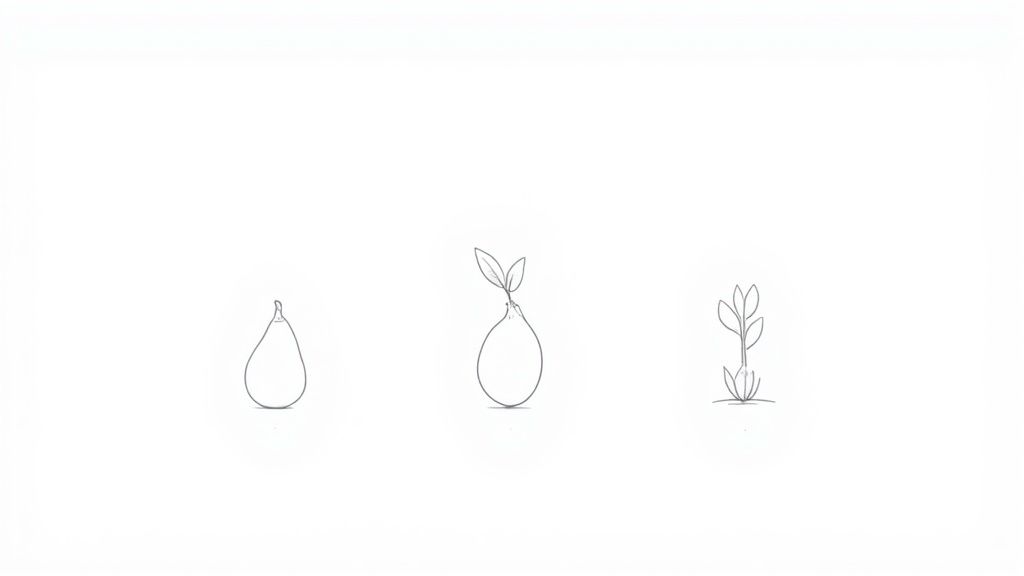In a crowded social media feed, a striking image or a compelling video isn't just nice to have; it's essential for survival. But stopping the scroll is only half the battle. To truly connect with an audience, build a brand, and drive action, your visuals need to tell a story. This is where mastering visual storytelling techniques becomes a critical skill for any creator or marketer. Moving beyond aesthetics, these methods transform simple posts into memorable narratives that resonate deeply with viewers.
This guide breaks down seven powerful and practical visual storytelling techniques you can implement immediately. We're not just talking about theories; we are diving into actionable steps for each one. You will learn how to structure a visual hero's journey, turn boring data into a compelling narrative, use color psychology to evoke specific emotions, and create interactive experiences that captivate your followers.
Each technique is detailed with specific examples and tips tailored for social media platforms like Instagram, TikTok, and LinkedIn. Think of this as your playbook for creating content that doesn't just get seen but gets felt. The principles behind crafting a single powerful image are also key. For additional insights into the visual elements driving online engagement, consider the effective use of featured images in digital content. Let's explore the methods that will elevate your content from passive viewing to active engagement.
1. The Hero's Journey Visual Arc
The Hero's Journey is a classic narrative pattern where a protagonist goes on an adventure, wins a victory in a decisive crisis, and comes home transformed. Applying this as a visual arc means mapping this emotional journey onto your visuals, creating a powerful and relatable story without saying a word. This is one of the most effective visual storytelling techniques because it taps into a structure we instinctively understand.
Instead of just telling a story, you show the transformation. The visual arc takes your audience from a familiar "before" state to an aspirational "after" state, with your product, service, or message acting as the catalyst for change. It’s perfect for case studies, testimonials, and brand origin stories.
How It Works Visually
The arc is built with deliberate visual shifts. The beginning (the "Ordinary World") might use muted colors, flat lighting, and static compositions. As the hero faces challenges, the visuals can become darker, more chaotic, or use Dutch angles to create tension. The climax should be visually striking, perhaps using a burst of color or dynamic lighting. Finally, the "Return" is depicted with bright, warm, and balanced visuals, showing the positive transformation.
Key Insight: The visual mood should directly reflect the hero's internal state at each stage of the journey. A struggling hero's world should look and feel different from a triumphant hero's world.
Practical Steps for Social Media:
-
Instagram Carousel: Dedicate each slide to a stage.
- Slide 1: The "before" shot, showing the initial problem (e.g., messy desk, dull skin).
- Slides 2-4: The "journey" begins, showing the product being used or the process of change.
- Slide 5: The "climax" or result, a dramatic and satisfying reveal (e.g., the organized desk, glowing skin).
-
Short-Form Video (Reels/TikTok): Use quick cuts to show the progression. Start with a 1-2 second clip of the problem. Rapidly cut through the "struggle" or "process" clips. End with a longer, impactful shot of the final, transformed state. Use trending audio that builds in intensity to match the visual arc.
2. Data Visualization Storytelling
Data Visualization Storytelling is the art of transforming complex data into a clear, compelling, and understandable narrative. Instead of presenting raw numbers or dense charts, this technique uses design principles to reveal insights and guide an audience to a specific conclusion. This is one of the most persuasive visual storytelling techniques because it grounds your narrative in hard evidence, building trust and authority.
This approach turns abstract statistics into something tangible and memorable. It’s perfect for annual reports, market research summaries, or proving the impact of your work. By presenting data as a story, you make it accessible and persuasive, helping your audience see the patterns and trends that matter most, from your own content performance analysis to global trends.
How It Works Visually
The core idea is to lead the viewer's eye intentionally. This is achieved through a strong visual hierarchy, where the most important data point is the most prominent. It uses color, size, and placement to create a path through the information. A story might start with a broad overview (a large, simple chart), then progressively disclose more detail, using annotations or call-outs to explain what the numbers mean. The goal is to build a conclusion step-by-step, not overwhelm with data.
Key Insight: Don't just show data; interpret it. Your visual choices should tell the audience what is important and why they should care about it.
Practical Steps for Social Media:
-
Instagram Carousel: Use each slide to build the data story.
- Slide 1: Pose a compelling question and show the single most important statistic (e.g., "What was our biggest success in Q3?").
- Slides 2-4: Break down the supporting data points with simple charts or infographics. Use consistent colors and fonts.
- Slide 5: Present the final conclusion or key takeaway, summarizing the story the data tells.
-
Short-Form Video (Reels/TikTok): Animate the data to make it dynamic. Use an animated bar chart race to show change over time, or use text overlays that appear in sequence to explain a key chart. Match the reveals to the beat of a trending audio track to make complex information feel engaging and easy to digest.
3. Visual Metaphor and Symbolism
A visual metaphor communicates a complex idea by representing it as something else, creating a powerful shortcut to understanding. This technique uses symbolism to connect an abstract concept (like freedom, security, or innovation) with a tangible, relatable image. This is one of the most intellectually engaging visual storytelling techniques because it invites the audience to make a connection themselves, making the message more memorable.
Instead of stating a benefit directly, you show it through a symbolic comparison. A padlock doesn't just mean "locked"; it can symbolize digital security, financial safety, or a secret revealed. This method makes abstract ideas concrete and powerful, ideal for brands wanting to convey deep values or complex features in a single, impactful image.

How It Works Visually
The key is to choose a symbol that is instantly recognizable to your audience but used in a novel context. For instance, Apple’s legendary "1984" commercial didn't talk about features; it used Orwellian imagery to metaphorically position itself as a liberator against a monolithic competitor. Similarly, WWF often depicts endangered animals crafted from fragile materials like glass or leaves, symbolizing their vulnerability without a single word of text. The power comes from the juxtaposition of the known symbol with the new idea you want to convey.
Key Insight: The most effective visual metaphors feel both surprising and inevitable. The audience should think, "I've never seen it that way before, but it makes perfect sense."
Practical Steps for Social Media:
-
Instagram Post: Create a single, striking image that embodies your core message. A software company might show a complex knot being untangled to represent problem-solving. A wellness brand could use an image of a wilting plant being watered, transforming into a vibrant one, to symbolize rejuvenation. The caption can then briefly explain the metaphor.
-
Short-Form Video (Reels/TikTok): Use a quick visual transformation to land the metaphor. Start with a shot of a tangled chain. With a "snap" transition, show it transformed into a perfectly straight, strong line. This can represent concepts like "streamlining your workflow" or "simplifying your finances." The fast-paced format makes the symbolic reveal satisfying and shareable.
4. Sequential Visual Storytelling
Sequential Visual Storytelling is the art of breaking down a narrative into a series of connected images that guide an audience through a story, moment by moment. Much like a comic book or a storyboard, this technique uses individual frames to build a cohesive and compelling narrative. This is one of the most versatile visual storytelling techniques because it gives you precise control over pacing and detail.
Instead of a single, static image, you create a visual journey that unfolds over time and space. This method excels at building context, developing characters, and explaining complex processes. It’s ideal for brand origin stories, product tutorials, event recaps, and in-depth visual journalism, as seen in The New York Times' features.

How It Works Visually
The technique relies on creating a clear visual flow from one frame to the next. Consistency is crucial: characters, environments, and color palettes should remain coherent to avoid confusing the audience. The pacing is controlled by the size, detail, and arrangement of each visual panel. A quick succession of small, simple frames can create a sense of speed, while a large, detailed frame encourages the viewer to pause and absorb the moment.
Key Insight: The space between the frames is just as important as the frames themselves. This "gutter" invites the audience to use their imagination to fill in the gaps, making them an active participant in the story.
Practical Steps for Social Media:
-
Instagram Carousel: This format is tailor-made for sequential storytelling.
- Slide 1: An establishing shot that sets the scene or introduces the main character.
- Slides 2-9: A series of frames showing the progression of the story. Use a mix of wide shots, medium shots, and close-ups to create a dynamic rhythm.
- Slide 10: The conclusion or call-to-action, providing a satisfying end to the sequence.
-
Short-Form Video (Reels/TikTok): Use a "photo dump" or quick-cut style. Show a series of still images in a rapid sequence set to music. Each photo acts as a panel in the story, conveying a complete narrative arc in just a few seconds, perfect for a "day in the life" or event highlight.
5. Color Psychology Storytelling
Color is more than just an aesthetic choice; it’s a powerful, non-verbal language that speaks directly to our emotions. Color psychology storytelling is a visual technique that strategically uses specific hues to evoke feelings, guide the audience's attention, and build a narrative’s emotional core. This is one of the most subtle yet impactful visual storytelling techniques, as it can completely change the mood and meaning of a scene without a single word.
Instead of leaving color to chance, this method involves building a deliberate palette where each color serves the story. From the bold, exciting red of Coca-Cola to the calming, trustworthy blue of Tiffany & Co., brands have long used color to define their identity and connect with consumers on a subconscious level. It's perfect for setting a tone, highlighting key themes, and showing character development.

How It Works Visually
The technique relies on the psychological associations we have with different colors. For example, a scene drenched in blues and grays can feel somber or melancholic, while one filled with yellows and oranges feels optimistic and energetic. A narrative can transition from cool tones to warm tones to signify a character’s emotional growth or a positive change in their circumstances, as seen in many of Wes Anderson’s films where palettes define entire story acts.
Key Insight: A consistent color palette creates a cohesive visual world, making your story more immersive and your brand more memorable. The colors you choose become a silent narrator.
Practical Steps for Social Media:
-
Instagram Grid: Plan your grid aesthetic around a core color palette that reflects your brand’s personality (e.g., earthy tones for a wellness brand, vibrant neons for a tech startup). Use a consistent filter or preset to maintain this color story across all posts, creating a powerful first impression for profile visitors.
-
Short-Form Video (Reels/TikTok): Use color grading to shift the mood within a single video. Start with a desaturated or blue-tinted clip to represent a "problem." As the solution is introduced, transition the visuals to become warmer, brighter, and more saturated. This color shift provides a satisfying emotional payoff that enhances the narrative.
6. Interactive and Immersive Storytelling
Interactive and Immersive Storytelling moves beyond passive viewing by inviting the audience to become a part of the narrative. This dynamic approach uses technology like AR, VR, polls, and clickable elements to give the user control, transforming them from a spectator into a participant. As one of the more technologically advanced visual storytelling techniques, it forges a deep, personal connection by making the story responsive to the user’s choices.
This method is powerful because it creates a memorable, personalized experience. When an audience member can influence the outcome or explore a virtual space, they develop a sense of ownership and agency in the story. This is ideal for brands wanting to demonstrate a product's utility in a real-world context (like IKEA's AR app) or for creators looking to build deeply engaging, multi-path narratives.
How It Works Visually
Visually, this technique relies on a user-centric interface. The design must be intuitive, with clear calls-to-action (CTAs), navigational cues, and responsive feedback. For AR, it involves overlaying digital graphics onto the real world through a device camera. In VR, it means creating a fully realized 360-degree digital environment. For simpler interactive stories on social media, it involves using platform features like polls, quizzes, or "tap-to-reveal" stickers that visually alter the content based on user input.
Key Insight: The goal isn't just to add clicks; it's to make each interaction meaningful. The user's choice should have a tangible impact on the visual narrative they experience.
Practical Steps for Social Media:
-
Instagram Stories: Use the "Poll" or "Quiz" sticker to let your audience vote on what happens next in a story sequence. Show the consequence of their choice in the following Story slide. For example, a travel creator could ask, "Explore the market or the beach?" and then post content from the winning location.
-
TikTok/Reels: Create "choose your own adventure" style videos. End a short video with two distinct choices presented as on-screen text. Instruct users to visit your profile to find two new, separate videos, each corresponding to one of the choices, allowing them to continue their unique story path. This requires careful planning, which you can learn more about in our guide to content planning strategies on postiz.com.
7. Minimalist Visual Storytelling
Minimalist Visual Storytelling is a powerful approach that embraces the "less is more" philosophy. It strips away visual clutter to tell a story with only the most essential elements, creating a narrative that is clear, focused, and impactful. This is one of the most sophisticated visual storytelling techniques because it relies on the audience's imagination to fill in the gaps, making the message more personal and memorable.
Instead of overwhelming the viewer with information, minimalism uses negative space, simple forms, and a limited color palette to direct attention precisely where it matters. This technique is perfect for luxury brands, tech companies, and any message that needs to convey elegance, clarity, and confidence. Think of Apple's product reveals or the clever negative space in the FedEx logo; both tell a story of simplicity and efficiency.
How It Works Visually
This technique is defined by what is left out. A minimalist composition uses generous amounts of white or negative space to create breathing room and draw the eye to a single focal point. Colors are often monochromatic or a highly restricted palette to evoke a specific mood without distraction. Typography becomes a key design element, chosen for its clean lines and readability. Every single element on the screen must have a distinct purpose; if it doesn't add to the story, it's removed.
Key Insight: Minimalism isn't about having less; it's about making sure every single element serves a purpose and tells a part of the story. The empty space is just as important as the subject itself.
Practical Steps for Social Media:
-
Instagram Post: Create a single, striking image with a solitary subject against a clean background. Use a simple, bold caption. For example, a single high-quality product photo with no props, letting the design speak for itself. You can find more ideas in our guide on content creation best practices.
-
Short-Form Video (Reels/TikTok): Use a static shot with one subtle movement to build intrigue. For example, a slow zoom-in on a product detail against a plain backdrop, or a single word of text fading in and out. Pair it with ambient, atmospheric audio rather than a loud, trending sound.
Visual Storytelling Techniques Comparison
| Technique | Implementation Complexity 🔄 | Resource Requirements ⚡ | Expected Outcomes 📊 | Ideal Use Cases 💡 | Key Advantages ⭐ |
|---|---|---|---|---|---|
| The Hero's Journey Visual Arc | Medium-High | Moderate to High | Strong emotional engagement and clear narrative | Complex stories needing universal resonance | Clear structure, broad cultural appeal |
| Data Visualization Storytelling | High | High (analytical + design skills) | Insightful, credible, and digestible info | Data-driven narratives, reports, presentations | Makes complex data accessible |
| Visual Metaphor and Symbolism | Medium | Moderate | Deep emotional resonance and layered meanings | Abstract ideas, emotional and cultural messaging | Powerful symbolism, transcends language |
| Sequential Visual Storytelling | Medium | Moderate | Controlled pacing and detailed visual flow | Comics, storyboards, multi-panel narratives | Excellent pacing, cost-effective |
| Color Psychology Storytelling | Low-Medium | Low to Moderate | Immediate emotional impact with subconscious influence | Branding, emotional tone setting | Cost-effective, strong emotional cues |
| Interactive and Immersive Storytelling | Very High | Very High | High engagement, personalized experiences | VR/AR, interactive media, user-driven stories | Extreme engagement, personalization |
| Minimalist Visual Storytelling | Low-Medium | Low to Moderate | Clear, focused, timeless narratives | Branding, clean design, where clarity is key | Strong focus, timeless aesthetics |
Bringing Your Visual Stories to Life
We've explored a powerful spectrum of visual storytelling techniques, moving from the epic structure of the Hero's Journey to the quiet impact of Minimalism. Each method offers a unique lens through which you can frame your narrative, connect with your audience, and leave a lasting impression. Whether you are translating complex numbers into a compelling narrative with data visualization or using a single, potent color to evoke a specific feeling, the core principle remains the same: you are guiding your audience on a journey, one frame at a time.
Mastering these techniques isn't about applying them all at once. Instead, it’s about building a versatile toolkit. The true art lies in knowing which tool to select for the story you want to tell and the audience you want to reach. A sequential comic strip might be perfect for a lighthearted Instagram story, while an immersive AR experience could be the key to a groundbreaking brand launch.
From Theory to Tangible Results
The journey from a great idea to a polished visual story requires both creativity and the right technical skills. The techniques discussed, from symbolism to color psychology, provide the creative framework. However, the final execution often depends on your ability to refine your raw assets into a cohesive narrative. For instance, aerial shots can offer a breathtaking perspective, establishing a scene or symbolizing freedom. Once you've captured your footage, mastering drone video editing software is crucial for enhancing your aerial filmmaking and truly bringing your visual stories to life. The editing process is where you apply color grades, set the pacing, and weave individual shots into a powerful sequence.
Your Next Steps in Visual Storytelling
The most effective way to grow is through practice. Don't be afraid to experiment. Your audience is your best feedback loop; pay attention to what resonates, what sparks conversation, and what drives action. Here are some actionable steps you can take today:
- Choose One Technique: Pick one of the visual storytelling techniques from this article that you haven't tried before. Brainstorm a simple story or message and create a short piece of content around it for your primary social media channel.
- Analyze Your Favorites: Scroll through your feed and find three posts from creators or brands you admire. Try to identify which of these techniques they are using. Deconstruct why their content is so effective.
- Start a Storyboard: Before your next big post or campaign, take ten minutes to sketch a simple storyboard. Even a rough outline can help you clarify your visual narrative and ensure every element serves a purpose.
Ultimately, great visual storytelling is about creating a connection. It’s about making your audience feel something, remember something, and share something. By intentionally applying these visual storytelling techniques, you transform from a content creator into a true storyteller, building a more engaged community one compelling visual at a time.
Ready to streamline your content creation and bring your visual stories to life more efficiently? Postiz helps you plan, schedule, and publish your content across all your social platforms from one simple dashboard. Stop juggling multiple apps and start focusing on what you do best: creating. Try Postiz today and take control of your content calendar.





